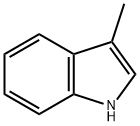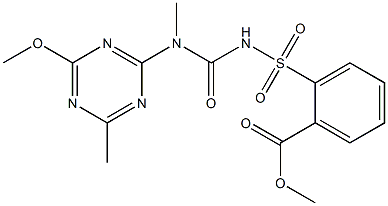PRODUCT Properties
| Melting point: | 92-97 °C (lit.) |
| Boiling point: | 265-266 °C (lit.) |
| Density | 1.0111 (estimate) |
| refractive index | 1.6070 (estimate) |
| FEMA | 3019 | SKATOLE |
| Flash point: | 132 °C |
| storage temp. | Store below +30°C. |
| solubility | Chloroform (Slightly), Methanol (Slightly) |
| pka | 17.30±0.30(Predicted) |
| form | Crystalline Powder or Flakes |
| color | Almost white to pale brown |
| Odor | indole-like odor |
| Odor Threshold | 0.0000056ppm |
| Odor Type | animal |
| biological source | synthetic |
| Water Solubility | Soluble in water, Ether, Alcohols, Benzene, Acetone, Chloroform. |
| Sensitive | Light Sensitive |
| Merck | 14,8560 |
| JECFA Number | 1304 |
| BRN | 111296 |
| Stability: | Stable, but light-sensistive. Stench! Incompatible with strong oxidizing agents, strong acids, acid ahydrides, acid chlorides. Combustible. |
| InChIKey | ZFRKQXVRDFCRJG-UHFFFAOYSA-N |
| LogP | 2.60 |
| CAS DataBase Reference | 83-34-1(CAS DataBase Reference) |
| NIST Chemistry Reference | 1H-Indole, 3-methyl-(83-34-1) |
| EPA Substance Registry System | 3-Methylindole (83-34-1) |
Description and Uses
3-Methylindole is a naturally abundant pneumotoxin, found primarily in mammalian feces providing its strong fecal odor. In lower concentrations however, the compound has a pleasent aroma, giving orange blossoms and ja smine their pleasing scent. It is often a component of commercial fragrances and perfumes.It helps fluorescent guanosine analogue, which in a dimethoxytrityl, phosphoramidite protected form, can be site-specifically inserted into oligonucleotides through a 3'-5' phosphodiester linkage using an automated DNA synthesizer.
Safety
| Symbol(GHS) |  GHS09 |
| Signal word | Warning |
| Hazard statements | H411 |
| Precautionary statements | P273-P391-P501 |
| Hazard Codes | Xi,N |
| Risk Statements | 36/37/38-51/53 |
| Safety Statements | 26-36-61 |
| RIDADR | UN3077 - class 9 - PG 3 - DOT/IATA UN3335 - Environmentally hazardous substances, solid, n.o.s., HI: all (not BR) |
| WGK Germany | 2 |
| RTECS | NM0350000 |
| F | 8-13 |
| TSCA | Yes |
| HS Code | 29339920 |
| Hazardous Substances Data | 83-34-1(Hazardous Substances Data) |
| Toxicity | MLD in frogs (mg/kg): 1000 s.c. (Bin-Ichi) |



